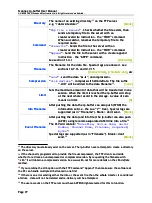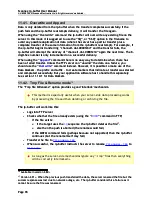
Scannex ip.buffer User Manual
© UK 2007-2021 Scannex Electronics Ltd. All rights reserved worldwide.
Pass-through Mode Diagrams
The pass-through socket is not connected. The protocol has full read/write access to the
source. Data that is received on the source is processed and stored normally.
When connected, the pass-through socket has full access to the source. Since the protocol
does not “see” any received data from the source, nothing is processed and stored while
the pass-through socket is connected
When connected, the pass-through socket has full access to the source. The protocol and
storage will still store all data arriving at the source, even when the pass-through socket is
connected
When connected, the pass-through socket will show all data arriving at the source.
However, the pass-through socket cannot write any data to the source. The protocol, and
storage, has full access to the source
“Debug” mode is similar to “Monitor” except that encoded data, and event information, is
sent to the pass-through socket. The pass-through socket still cannot write data to the
source.
47
Protocols that are bidirectional packet based, like the Avaya RSP, will prohibit this mode.
48
Protocols that are bidirectional packet based, like the Avaya RSP, will prohibit this mode.
49
For non-bidirectional sources, like FTP Server and UDP, this is the only available mode.
Page 90
“Stored”
Source
Protocol
Passthru
Pass-through not connected
Source
Protocol
Passthru
“Monitor”
Source
Protocol
Passthru
“Not Stored”
Source
Protocol
Passthru
Scannex ip.buffer User Manual
© UK 2007-2021 Scannex Electronics Ltd. All rights reserved worldwide.
Pass-through Mode Diagrams
The pass-through socket is not connected. The protocol has full read/write access to the
source. Data that is received on the source is processed and stored normally.
When connected, the pass-through socket has full access to the source. Since the protocol
does not “see” any received data from the source, nothing is processed and stored while
the pass-through socket is connected
When connected, the pass-through socket has full access to the source. The protocol and
storage will still store all data arriving at the source, even when the pass-through socket is
connected
When connected, the pass-through socket will show all data arriving at the source.
However, the pass-through socket cannot write any data to the source. The protocol, and
storage, has full access to the source
“Debug” mode is similar to “Monitor” except that encoded data, and event information, is
sent to the pass-through socket. The pass-through socket still cannot write data to the
source.
47
Protocols that are bidirectional packet based, like the Avaya RSP, will prohibit this mode.
48
Protocols that are bidirectional packet based, like the Avaya RSP, will prohibit this mode.
49
For non-bidirectional sources, like FTP Server and UDP, this is the only available mode.
Page 90
“Stored”
Source
Protocol
Passthru
Pass-through not connected
Source
Protocol
Passthru
“Monitor”
Source
Protocol
Passthru
“Not Stored”
Source
Protocol
Passthru






























